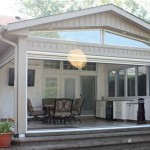Ideas To Update Your Concrete Patio
Concrete patios, known for their durability and affordability, can sometimes appear bland and uninviting. Over time, they can become stained, cracked, or simply outdated. However, updating a concrete patio doesn't necessarily require a complete demolition. With careful planning and execution, a concrete patio can be transformed into an attractive and functional outdoor living space. This article will explore several ideas for updating a concrete patio, encompassing a range of budgets and skill levels.
Cleaning and Repairing Existing Concrete
Before undertaking any significant transformation, a thorough cleaning and repair of the existing concrete surface is crucial. Years of exposure to the elements can leave concrete patios covered in dirt, grime, mildew, and stains. Addressing these issues provides a clean slate for any subsequent updates and enhances the overall appearance, even without further modifications.
Begin by sweeping away loose debris and using a stiff-bristled brush to scrub the surface. For stubborn stains and mildew, a solution of water and a specialized concrete cleaner is recommended. Power washing can be effective, but it's essential to use a low-pressure setting to avoid damaging the concrete. Furthermore, be mindful of the surrounding landscaping and avoid directing the water stream towards plants or sensitive areas.
Cracks and minor surface imperfections should be addressed before any decorative treatments are applied. Small cracks can often be filled with a concrete patching compound, available at most hardware stores. Larger cracks may require professional attention to ensure structural integrity. Following the manufacturer’s instructions is critical when applying patching compounds to ensure proper adhesion and longevity. Ensure the patched areas are blended seamlessly with the surrounding concrete for a uniform look.
Repairing spalled concrete, where the surface has chipped or flaked away, requires more extensive preparation. Remove any loose or crumbling concrete, clean the area thoroughly, and apply a concrete bonding agent before patching with a suitable repair mortar. Feathering the edges of the patch helps create a smooth transition between the repair and the existing concrete.
Decorative Concrete Coatings and Finishes
Once the concrete patio is clean and repaired, a variety of decorative coatings and finishes can be applied to enhance its appearance and protect it from future damage. These options range from simple sealers to more elaborate epoxy coatings and overlays, each offering different aesthetic qualities and performance characteristics.
Concrete sealers are a relatively inexpensive and easy-to-apply option that provides a protective layer against water, stains, and UV damage. They are available in various finishes, including matte, satin, and gloss. Sealers can also enhance the color of the concrete, bringing out its natural tones or adding a subtle tint. A penetrating sealer is often preferred, as it soaks into the concrete, providing longer-lasting protection than a surface coating.
Concrete stains offer a more permanent way to alter the color of the concrete. Acid stains react chemically with the concrete, creating unique and variegated color patterns. Water-based stains offer a wider range of color options and are more environmentally friendly. Staining concrete requires careful preparation and application, including proper etching and neutralizing of the surface. Always test the stain in an inconspicuous area before applying it to the entire patio.
Epoxy coatings provide a durable and aesthetically pleasing finish, available in a wide range of colors and textures. They are resistant to chemicals, abrasion, and UV damage, making them ideal for high-traffic areas. Epoxy coatings can also be customized with decorative flakes, metallic pigments, or quartz aggregates to create unique and visually appealing surfaces. Proper surface preparation is essential for epoxy coatings to adhere properly to the concrete. This typically involves grinding or acid-etching the surface to create a profile that the epoxy can bond to.
Concrete overlays are thin layers of cement-based material that are applied over existing concrete to create a new surface. Overlays can be textured, stamped, or stenciled to resemble various materials, such as brick, stone, or tile. They are a versatile option for covering up damaged or unsightly concrete surfaces and creating a completely new look. Polymer-modified overlays offer improved durability and flexibility compared to traditional cement-based overlays. The installation of overlays often requires specialized tools and skills, and may be best left to professionals.
Adding Features & Furnishings to Enhance the Patio Space
Beyond the concrete surface itself, the overall ambiance of a patio can be significantly improved by adding features and furnishings that enhance its functionality and aesthetic appeal. These additions can range from simple outdoor furniture to more elaborate structures such as pergolas and outdoor kitchens.
Outdoor furniture is essential for creating a comfortable and inviting patio space. Choose furniture that is durable, weather-resistant, and appropriate for the size of the patio. Consider the style and intended use of the patio when selecting furniture. Dining sets are ideal for outdoor meals, while lounge chairs and sofas are perfect for relaxation and conversation. Incorporate cushions and pillows in a variety of colors and patterns to add visual interest and comfort.
Outdoor rugs can define seating areas and add a touch of warmth and texture to the patio. Look for rugs made from durable, weather-resistant materials such as polypropylene or recycled plastic. Choose rugs that complement the colors and style of the furniture and the surrounding landscape.
Adding plants and greenery is a simple and effective way to soften the hardscape and create a more inviting atmosphere. Potted plants, hanging baskets, and window boxes can add color and texture to the patio. Consider the amount of sunlight the patio receives when selecting plants. Drought-tolerant plants are a good choice for patios that receive a lot of sun. Trees and shrubs can also be planted around the perimeter of the patio to provide shade and privacy. Container gardening is a versatile option, as it allows you to easily move plants around to create different arrangements.
Outdoor lighting can extend the usability of the patio into the evening hours and create a warm and inviting ambiance. String lights, lanterns, and spotlights can be used to illuminate different areas of the patio. Consider using solar-powered lights to save energy. Path lighting can improve safety and visibility. Dimmable lights allow you to adjust the brightness to create the perfect mood. Installing a fire pit or outdoor fireplace can provide warmth and a focal point for the patio.
Pergolas provide shade and create a defined outdoor living space. They can be constructed from wood, metal, or vinyl and can be customized to fit the size and style of the patio. Climbing plants can be trained to grow on pergolas, providing additional shade and visual interest. Adding a retractable awning to a pergola can provide even greater protection from the sun and rain.
An outdoor kitchen is a great addition for those who enjoy cooking and entertaining outdoors. Outdoor kitchens can be as simple as a grill and a countertop or as elaborate as a full-fledged kitchen with a sink, refrigerator, and storage. Consider the size of the patio and the available space when designing an outdoor kitchen. Ensure that the outdoor kitchen is properly ventilated to prevent smoke from becoming a nuisance.
Adding a water feature, such as a fountain or pond, can create a relaxing and peaceful atmosphere on the patio. The sound of running water can help to mask unwanted noise and create a sense of tranquility. Water features can be incorporated into the landscape surrounding the patio or placed directly on the patio itself.
Screens or curtains can provide privacy and protection from the elements. They can be made from a variety of materials, such as fabric, bamboo, or woven vinyl. Screens can be used to create a more intimate and enclosed space. Curtains can be used to block sunlight and wind.
Ultimately, updating a concrete patio involves a combination of practical repairs and aesthetic enhancements. By carefully considering the existing condition of the concrete, selecting appropriate coatings and finishes, and adding thoughtful features and furnishings, a concrete patio can be transformed into a beautiful and functional outdoor living space that complements the home and enhances the enjoyment of the surrounding environment.

5 Ways To Upgrade Your Concrete Patio

7 Concrete Patio Design Ideas To Enhance Your Home

Diy Ideas To Update Your Worn Out Concrete Patio Outdoor Backyards

6 Concrete Patio Ideas To Boost The Appeal Of That Drab Slab

9 Great Concrete Patio Ideas For A Makeover Remodelaholic

50 Stunning Concrete Patio Ideas To Elevate Your Backyard Designs Design

Inexpensive Ways To Cover A Concrete Patio

5 Ways To Update A Concrete Patio Improvements

Backyard Stained And Stamped Concrete Patios

9 Great Concrete Patio Ideas For A Makeover Remodelaholic
Related Posts








